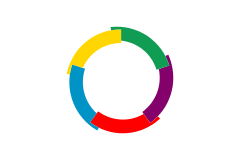Comoros
The Comoros (/ˈkɒməroʊz/ (![]()
Union of the Comoros
| |
|---|---|
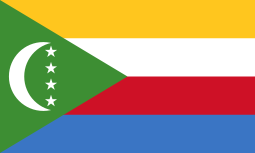 Flag
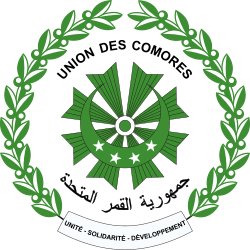 Seal
| |
Motto:
| |
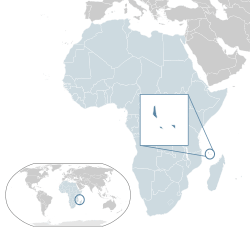 Location of the Comoros (dark blue) – in Africa (light blue & dark grey) | |
| Capital and largest city | Moroni 11°41′S 43°16′E |
| Official languages |
|
| Ethnic groups | |
| Religion | Sunni Islam |
| Demonym(s) | Comorian |
| Government | Federal presidential republic |
• President | Azali Assoumani |
• President of the Assembly | Abdou Ousseni |
| Legislature | Assembly of the Union |
| Formation | |
• Discovery by Portuguese explorers | 1503 |
| 1886 | |
• Protectorate of the Comoros | 6 September 1887 |
• Territory under French Madagascar | 9 April 1908 |
• Overseas territory | 27 October 1946 |
• State of Comoros | 22 December 1961 |
• Independence from France | 6 July 1975 |
• Federal and Islamic Republic of Comoros | 24 May 1978 |
• Union of the Comoros | 23 December 2001 |
| 17 May 2009 | |
| Area | |
• Total | 1,659 km2 (641 sq mi) (171tha) |
• Water (%) | negligible |
| Population | |
• 2018 estimate | 850,688 (160th) |
• Density | 457/km2 (1,183.6/sq mi) (27th) |
| GDP (PPP) | 2019 estimate |
• Total | $2.446 billion[1] (178th) |
• Per capita | $2,799[1] (177th) |
| GDP (nominal) | 2019 estimate |
• Total | $1.179 billion[1] (182nd) |
• Per capita | $1,349[1] (165th) |
| Gini (2013) | medium · 141st |
| HDI (2018) | low · 156th |
| Currency | Comorian franc (KMF) |
| Time zone | UTC+3 (EAT) |
| Driving side | right |
| Calling code | +269 |
| ISO 3166 code | KM |
| Internet TLD | .km |
At 1,660 km2 (640 sq mi), excluding the contested island of Mayotte, the Comoros is the fourth-smallest African nation by area. The population, excluding Mayotte, is estimated at 832,322 as of 2018.[4][5] As a nation formed at a crossroads of different civilisations, the archipelago is noted for its diverse culture and history. The archipelago was first settled by Bantu speakers who came from East Africa, Arabs and Austronesians.
The sovereign state is an archipelago consisting of three major islands and numerous smaller islands, all in the volcanic Comoro Islands. The major islands are commonly known by their French names: northwestern-most Grande Comore (Ngazidja), Mohéli (Mwali), and Anjouan (Ndzuani). In addition, the country has a claim on a fourth major island, southeastern-most Mayotte (Maore), though Mayotte voted against independence from France in 1974, has never been administered by an independent Comoros government, and continues to be administered by France (currently as an overseas department). France has vetoed United Nations Security Council resolutions that would affirm Comorian sovereignty over the island.[6][7][8][9] In addition, Mayotte became an overseas department and a region of France in 2011 following a referendum passed overwhelmingly.
The archipelago became part of the French colonial empire during the 19th century before becoming independent in 1975. Since declaring independence, the country has experienced more than 20 coups d'état or attempted coups, with various heads of state assassinated.[10][11] Along with this constant political instability, the population of the Comoros lives with the worst income inequality of any nation, with a Gini coefficient over 60%, while also ranking in the worst quartile on the Human Development Index. As of 2008 about half the population lived below the international poverty line of US$1.25 a day.[12] The French insular region of Mayotte, which is the most prosperous territory in the Mozambique Channel, is a major destination for migrants from the independent islands. The Comoros is a member state of the Arab League, the African Union, Francophonie, the Organisation of Islamic Cooperation, and the Indian Ocean Commission. Other countries near the Comoros are Tanzania to the northwest and the Seychelles to the northeast. Its capital is Moroni, on Grande Comore. The Union of the Comoros has three official languages—Comorian, French, and Arabic.
History
Settlement
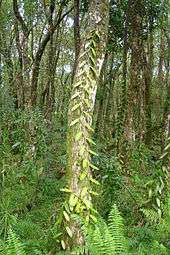
According to mythology, a jinni (spirit) dropped a jewel, which formed a great circular inferno. This became the Karthala volcano, which created the island of Grande Comoro. King Solomon is also said to have visited the island.
The first attested human inhabitants of the Comoro Islands are now thought to have been Austronesian settlers travelling by boat from islands in Southeast Asia.[14][15] These people arrived no later than the eighth century AD, the date of the earliest known archaeological site, found on Mayotte, although settlement beginning as early as the first century has been postulated.[16]
Subsequent settlers came from the east coast of Africa, the Arabian Peninsula and the Persian Gulf, the Malay Archipelago, and Madagascar. Bantu-speaking settlers were present on the islands from the beginnings of settlement, probably brought to the islands as slaves.[17]
Development of the Comoros is divided into phases. The earliest reliably recorded phase is the Dembeni phase (eighth to tenth centuries), during which there were several small settlements on each island.[18] From the eleventh to the fifteenth centuries, trade with the island of Madagascar and merchants from the Swahili coast and the Middle East flourished, more villages were founded and existing villages grew. Many Comorians can trace their genealogies to ancestors from the Arabian peninsula, particularly Hadhramaut, who arrived during this period.
Medieval Comoros
According to legend, in 632, upon hearing of Islam, islanders are said to have dispatched an emissary, Mtswa-Mwindza, to Mecca—but by the time he arrived there, the Prophet Muhammad had died. Nonetheless, after a stay in Mecca, he returned to Ngazidja and led the gradual conversion of his islanders to Islam.[19]
Among the earliest accounts of East Africa, the works of Al-Masudi describe early Islamic trade routes, and how the coast and islands were frequently visited by Muslims including Persian and Arab merchants and sailors in search of coral, ambergris, ivory, tortoiseshell, gold and slaves. They also brought Islam to the people of the Zanj including the Comoros. As the importance of the Comoros grew along the East African coast, both small and large mosques were constructed. The Comoros are part of the Swahili cultural and economic complex and the islands became a major hub of trade and an important location in a network of trading towns that included Kilwa, in present-day Tanzania, Sofala (an outlet for Zimbabwean gold), in Mozambique, and Mombasa in Kenya.[18]
The Portuguese arrived in the Indian Ocean at the end of the 15th century and the first Portuguese visit to the islands seems to have been that of Vasco da Gama's second fleet in 1503.[20] For much of the 16th century the islands provided provisions to the Portuguese fort at Mozambique and although there was no formal attempt by the Portuguese crown to take possession, a number of Portuguese traders settled.
By the end of the 16th century the local rulers were beginning to push back and, with the support of the Omani Sultan Saif bin Sultan they began to defeat the Dutch and the Portuguese. His successor Said bin Sultan increased Omani Arab influence in the region, moving his administration to nearby Zanzibar, which came under Omani rule. Nevertheless, the Comoros remained independent, and although the three smaller islands were usually politically unified, the largest island, Ngazidja, was divided into a number of autonomous kingdoms (ntsi).[21]
By the time Europeans showed interest in the Comoros, the islanders were well placed to take advantage of their needs, initially supplying ships of the route to India, particularly the English and, later, slaves to the plantation islands in the Mascarenes.[22][21]
European contact and French colonisation

_-_CAMORA_excerpt.jpg)
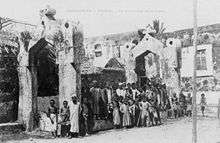
In the last decade of the 18th century, Malagasy warriors, mostly Betsimisaraka and Sakalava, started raiding the Comoros for slaves and the islands were devastated as crops were destroyed and the people were slaughtered, taken into captivity or fled to the African mainland: it is said that by the time the raids finally ended in the second decade of the 19th century only one man remained on Mwali.[23] The islands were repopulated by slaves from the mainland, who were traded to the French in Mayotte and the Mascarenes. On the Comoros, it was estimated in 1865 that as much as 40% of the population consisted of slaves.[24]
France first established colonial rule in the Comoros by taking possession of Mayotte in 1841 when the Sakalava usurper sultan Andriantsoly (also known as Tsy Levalo) signed the Treaty of April 1841,[25] which ceded the island to the French authorities.[26]
Meanwhile, Ndzuani (or Johanna as it was know to the British) continued to serve as a way station for English merchants sailing to India and the Far East, as well as American whalers, although the British gradually abandoned it following their possession of Mauritius in 1814 and by the time the Suez Canal opened in 1869 there was no longer any significant supply trade at Ndzuani. Local commodities exported by the Comoros were, in addition to slaves, coconuts, timber, cattle and tortoiseshell. French settlers, French-owned companies, and wealthy Arab merchants established a plantation-based economy that used about one-third of the land for export crops. After its annexation, France converted Mayotte into a sugar plantation colony. The other islands were soon transformed as well, and the major crops of ylang-ylang, vanilla, cloves, perfume plants, coffee, cocoa beans, and sisal were introduced.[27]
In 1886, Mwali was placed under French protection by its Sultan Mardjani Abdou Cheikh. That same year, despite having no authority to do so, Sultan Said Ali of Bambao, one of the sultanates on Ngazidja, placed the island under French protection in exchange for French support of his claim to the entire island, which he retained until his abdication in 1910. In 1908 the islands were unified under a single administration (Colonie de Mayotte et dépendances) and placed under the authority of the French colonial governor general of Madagascar. In 1909, Sultan Said Muhamed of Ndzuani abdicated in favour of French rule. In 1912 the colony and the protectorates were abolished and the islands became a province of the colony of Madagascar.[28]
Agreement was reached with France in 1973 for the Comoros to become independent in 1978, despite the deputies of Mayotte voting for increased integration with France. A referendum was held on all four of the islands. Three voted for independence by large margins, while Mayotte voted against, and remains under French administration. On 6 July 1975, however, the Comorian parliament passed a unilateral resolution declaring independence. Ahmed Abdallah proclaimed the independence of the Comorian State (État comorien; دولة القمر) and became its first president.
Independence (1975)
.svg.png)
.svg.png)

The next 30 years were a period of political turmoil. On 3 August 1975, less than one month after independence, president Ahmed Abdallah was removed from office in an armed coup and replaced with United National Front of the Comoros (FNUK) member Prince Said Mohamed Jaffar. Months later, in January 1976, Jaffar was ousted in favour of his Minister of Defense Ali Soilih.[29]
The population of Mayotte voted against independence from France in three referenda during this period. The first, held on all the islands on 22 December 1974, won 63.8% support for maintaining ties with France on Mayotte; the second, held in February 1976, confirmed that vote with an overwhelming 99.4%, while the third, in April 1976, confirmed that the people of Mayotte wished to remain a French territory. The three remaining islands, ruled by President Soilih, instituted a number of socialist and isolationist policies that soon strained relations with France. On 13 May 1978, Bob Denard returned to overthrow President Soilih and reinstate Abdallah with the support of the French, Rhodesian and South African governments. During Soilih's brief rule, he faced seven additional coup attempts until he was finally forced from office and killed.[29][30]
In contrast to Soilih, Abdallah's presidency was marked by authoritarian rule and increased adherence to traditional Islam[31] and the country was renamed the Federal Islamic Republic of the Comoros (République Fédérale Islamique des Comores; جمهورية القمر الإتحادية الإسلامية). Abdallah continued as president until 1989 when, fearing a probable coup d'état, he signed a decree ordering the Presidential Guard, led by Bob Denard, to disarm the armed forces. Shortly after the signing of the decree, Abdallah was allegedly shot dead in his office by a disgruntled military officer, though later sources claim an antitank missile was launched into his bedroom and killed him.[32] Although Denard was also injured, it is suspected that Abdallah's killer was a soldier under his command.[33]
A few days later, Bob Denard was evacuated to South Africa by French paratroopers. Said Mohamed Djohar, Soilih's older half-brother, then became president, and served until September 1995, when Bob Denard returned and attempted another coup. This time France intervened with paratroopers and forced Denard to surrender.[34][35] The French removed Djohar to Reunion, and the Paris-backed Mohamed Taki Abdoulkarim became president by election. He led the country from 1996, during a time of labour crises, government suppression, and secessionist conflicts, until his death November 1998. He was succeeded by Interim President Tadjidine Ben Said Massounde.[36]
The islands of Ndzuani and Mwali declared their independence from the Comoros in 1997, in an attempt to restore French rule. But France rejected their request, leading to bloody confrontations between federal troops and rebels.[37] In April 1999, Colonel Azali Assoumani, Army Chief of Staff, seized power in a bloodless coup, overthrowing the Interim President Massounde, citing weak leadership in the face of the crisis. This was the Comoros' 18th coup, or attempted coup d'état since independence in 1975.[38]
Azali failed to consolidate power and reestablish control over the islands, which was the subject of international criticism. The African Union, under the auspices of President Thabo Mbeki of South Africa, imposed sanctions on Ndzuani to help broker negotiations and effect reconciliation.[39][40] Under the terms of the Fomboni Accords, signed in December 2001 by the leaders of all three islands, the official name of the country was changed to the Union of the Comoros; the new state was to be highly decentralised and the central union government would devolve most powers to the new island governments, each lead by a president. The Union president, although elected by national elections, would be chosen in rotation from each of the islands every five years.
Azali stepped down in 2002 to run in the democratic election of the President of the Comoros, which he won. Under ongoing international pressure, as a military ruler who had originally come to power by force, and was not always democratic while in office, Azali led the Comoros through constitutional changes that enabled new elections.[41] A Loi des compétences law was passed in early 2005 that defines the responsibilities of each governmental body, and is in the process of implementation. The elections in 2006 were won by Ahmed Abdallah Mohamed Sambi, a Sunni Muslim cleric nicknamed the "Ayatollah" for his time spent studying Islam in Iran. Azali honoured the election results, thus allowing the first peaceful and democratic exchange of power for the archipelago.[42]
Colonel Mohammed Bacar, a French-trained former gendarme elected President of Ndzuani in 2001, refused to step down at the end of his five-year mandate. He staged a vote in June 2007 to confirm his leadership that was rejected as illegal by the Comoros federal government and the African Union. On 25 March 2008 hundreds of soldiers from the African Union and the Comoros seized rebel-held Ndzuani, generally welcomed by the population: there have been reports of hundreds, if not thousands, of people tortured during Bacar's tenure.[43] Some rebels were killed and injured, but there are no official figures. At least 11 civilians were wounded. Some officials were imprisoned. Bacar fled in a speedboat to the French Indian Ocean territory of Mayotte to seek asylum. Anti-French protests followed in the Comoros (see 2008 invasion of Anjouan). Bacar was eventually granted asylum in Benin.
Since independence from France, the Comoros experienced more than 20 coups or attempted coups.[10]
Following elections in late 2010, former Vice-President Ikililou Dhoinine was inaugurated as president on 26 May 2011. A member of the ruling party, Dhoinine was supported in the election by the incumbent President Ahmed Abdallah Mohamed Sambi. Dhoinine, a pharmacist by training, is the first President of the Comoros from the island of Mwali. Following the 2016 elections, Azali Assoumani, from Ngazidja, became president for a third term. In 2018 Azali held a referendum on constitutional reform that would permit a president to serve two terms. The amdendments passed, although the vote was widely contested and boycotted by the opposition, and in April 2019, and to widespread opposition, Azali was re-elected president to serve the first of potentially two five year terms.
Geography
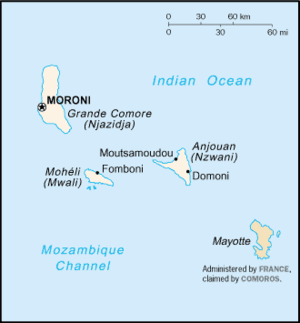
The Comoros is formed by Ngazidja (Grande Comore), Mwali (Mohéli) and Ndzuani (Anjouan), three major islands in the Comoros Archipelago, as well as many minor islets. The islands are officially known by their Comorian language names, though international sources still use their French names (given in parentheses above). The capital and largest city, Moroni, is located on Ngazidja. The archipelago is situated in the Indian Ocean, in the Mozambique Channel, between the African coast (nearest to Mozambique and Tanzania) and Madagascar, with no land borders.
At 1,660 km2 (640 sq mi), it is one of the smallest countries in the world. The Comoros also has claim to 320 km2 (120 sq mi) of territorial seas. The interiors of the islands vary from steep mountains to low hills.
Ngazidja is the largest of the Comoros Archipelago, approximately equal in area to the other islands combined. It is also the most recent island, and therefore has rocky soil. The island's two volcanoes, Karthala (active) and La Grille (dormant), and the lack of good harbours are distinctive characteristics of its terrain. Mwali, with its capital at Fomboni, is the smallest of the four major islands. Ndzuani, whose capital is Mutsamudu, has a distinctive triangular shape caused by three mountain chains – Shisiwani, Nioumakele and Jimilime – emanating from a central peak, Mount Ntingui (1,575 m or 5,167 ft).
The islands of the Comoros Archipelago were formed by volcanic activity. Mount Karthala, an active shield volcano located on Ngazidja, is the country's highest point, at 2,361 metres (7,746 feet). It contains the Comoros' largest patch of disappearing rainforest. Karthala is currently one of the most active volcanoes in the world, with a minor eruption in May 2006, and prior eruptions as recently as April 2005 and 1991. In the 2005 eruption, which lasted from 17 to 19 April, 40,000 citizens were evacuated, and the crater lake in the volcano's 3 by 4 kilometres (1.9 by 2.5 miles) caldera was destroyed.
The Comoros also lays claim to the Îles Éparses or Îles éparses de l'océan indien (Scattered Islands in the Indian Ocean) – Glorioso Islands, comprising Grande Glorieuse, Île du Lys, Wreck Rock, South Rock, Verte Rocks (three islets) and three unnamed islets – one of France's overseas districts. The Glorioso Islands were administered by the colonial Comoros before 1975, and are therefore sometimes considered part of the Comoros Archipelago. Banc du Geyser, a former island in the Comoros Archipelago, now submerged, is geographically located in the Îles Éparses, but was annexed by Madagascar in 1976 as an unclaimed territory. The Comoros and France each still view the Banc du Geyser as part of the Glorioso Islands and, thus, part of its particular exclusive economic zone.
Climate
The climate is generally tropical and mild, and the two major seasons are distinguishable by their raininess. The temperature reaches an average of 29–30 °C (84–86 °F) in March, the hottest month in the rainy season (called kashkazi/kaskazi [meaning north monsoon], which runs from December to April), and an average low of 19 °C (66 °F) in the cool, dry season (kusi (meaning south monsoon), which proceeds from May to November).[44] The islands are rarely subject to cyclones.
Ecology and environment
The Comoros constitute an ecoregion in their own right, Comoros forests.[45]
In December 1952 a specimen of the coelacanth fish was re-discovered off the Comoros coast. The 66 million-year-old species was thought to have been long extinct until its first recorded appearance in 1938 off the South African coast.[46] Between 1938 and 1975, 84 specimens were caught and recorded.[47]
Government
.jpg)
Politics of the Comoros takes place in a framework of a federal presidential republic, whereby the President of the Comoros is both head of state and head of government, and of a multi-party system. The Constitution of the Union of the Comoros was ratified by referendum on 23 December 2001, and the islands' constitutions and executives were elected in the following months. It had previously been considered a military dictatorship, and the transfer of power from Azali Assoumani to Ahmed Abdallah Mohamed Sambi in May 2006 was a watershed moment as it was the first peaceful transfer in Comorian history.
Executive power is exercised by the government. Federal legislative power is vested in both the government and parliament. The preamble of the constitution guarantees an Islamic inspiration in governance, a commitment to human rights, and several specific enumerated rights, democracy, "a common destiny" for all Comorians.[48] Each of the islands (according to Title II of the Constitution) has a great amount of autonomy in the Union, including having their own constitutions (or Fundamental Law), president, and Parliament. The presidency and Assembly of the Union are distinct from each of the islands' governments. The presidency of the Union rotates between the islands.[49] Despite widespread misgivings about the durability of the system of presidential rotation, Ngazidja holds the current presidency rotation, and Azali is President of the Union; Ndzuani is in theory to provide the next president.[50]
Legal system
The Comorian legal system rests on Islamic law, an inherited French (Napoleonic Code) legal code, and customary law (mila na ntsi). Village elders, kadis or civilian courts settle most disputes. The judiciary is independent of the legislative and the executive. The Supreme Court acts as a Constitutional Council in resolving constitutional questions and supervising presidential elections. As High Court of Justice, the Supreme Court also arbitrates in cases where the government is accused of malpractice. The Supreme Court consists of two members selected by the president, two elected by the Federal Assembly, and one by the council of each island.[49]
Political culture
Around 80 percent of the central government's annual budget is spent on the country's complex electoral system which provides for a semi-autonomous government and president for each of the three islands and a rotating presidency for the overarching Union government.[51] A referendum took place on 16 May 2009 to decide whether to cut down the government's unwieldy political bureaucracy. 52.7% of those eligible voted, and 93.8% of votes were cast in approval of the referendum. Following the implementation of the changes, each island's president became a governor and the ministers became councillors.[52]
Foreign relations
In November 1975, the Comoros became the 143rd member of the United Nations. The new nation was defined as comprising the entire archipelago, although the citizens of Mayotte chose to become French citizens and keep their island as a French territory.[53]
The Comoros has repeatedly pressed its claim to Mayotte before the United Nations General Assembly, which adopted a series of resolutions under the caption "Question of the Comorian Island of Mayotte", opining that Mayotte belongs to the Comoros under the principle that the territorial integrity of colonial territories should be preserved upon independence. As a practical matter, however, these resolutions have little effect and there is no foreseeable likelihood that Mayotte will become de facto part of the Comoros without its people's consent. More recently, the Assembly has maintained this item on its agenda but deferred it from year to year without taking action. Other bodies, including the Organization of African Unity, the Movement of Non-Aligned Countries and the Organisation of Islamic Cooperation, have similarly questioned French sovereignty over Mayotte.[6][54] To close the debate and to avoid being integrated by force in the Union of the Comoros, the population of Mayotte overwhelmingly chose to become an overseas department and a region of France in a 2009 referendum. The new status was effective on 31 March 2011 and Mayotte has been recognised as an outermost region by the European Union on 1 January 2014. This decision legally integrates Mayotte in the French Republic.
The Comoros is a member of the African Union, the Arab League, the European Development Fund, the World Bank, the International Monetary Fund, the Indian Ocean Commission and the African Development Bank. On 10 April 2008, the Comoros became the 179th nation to accept the Kyoto Protocol to the United Nations Framework Convention on Climate Change.[55] The Comoros signed the UN treaty on the Prohibition of Nuclear Weapons.[56]
In May 2013 the Union of the Comoros became known for filing a referral to the Office of the Prosecutor of the International Criminal Court (ICC) regarding the events of "the 31 May 2010 Israeli raid on the Humanitarian Aid Flotilla bound for [the] Gaza Strip". In November 2014 the ICC Prosecutor eventually decided[57] that the events did constitute war crimes but did not meet the gravity standards of bringing the case before ICC.[58] The emigration rate of skilled workers was about 21.2% in 2000.[59]
Military
The military resources of the Comoros consist of a small standing army and a 500-member police force, as well as a 500-member defence force. A defence treaty with France provides naval resources for protection of territorial waters, training of Comorian military personnel, and air surveillance. France maintains a few senior officers presence in the Comoros at government request. France maintains a small maritime base and a Foreign Legion Detachment (DLEM) on Mayotte.
Once the new government was installed in May–June 2011, an expert mission from UNREC (Lomé) came to the Comoros and produced guidelines for the elaboration of a national security policy, which were discussed by different actors, notably the national defence authorities and civil society.[60] By the end of the programme in end March 2012, a normative framework agreed upon by all entities involved in SSR will have been established. This will then have to be adopted by Parliament and implemented by the authorities.
Human rights
Both male and female same-sex sexual acts are illegal in Comoros.[61] Such acts are punished with up to five years imprisonment.[62]
Economy

The level of poverty in the Comoros is high, but "judging by the international poverty threshold of $1.9 per person per day, only two out of every ten Comorians could be classified as poor, a rate that places the Comoros ahead of other low-income countries and 30 percentage points ahead of other countries in Sub-Saharan Africa."[63] Poverty declined by about 10% between 2014 and 2018, and living conditions generally improved.[63] Economic inequality remains widespread, with a major gap between rural and urban areas.[63] Remittances through the sizable Comorian diaspora form a substantial part of the country's GDP[64] and have contributed to decreases in poverty and increases in living standards.[63]
According to ILO's ILOSTAT statistical database, between 1991 and 2019 the unemployment rate as a percent of the total labor force ranged from 4.38% to 4.3%.[65] An October 2005 paper by the Comoros Ministry of Planning and Regional Development, however, reported that "registered unemployment rate is 14.3 percent, distributed very unevenly among and within the islands, but with marked incidence in urban areas."[66]
In 2019, more than 56% of the labor force was employed in agriculture, with 29% employed in industry and 14% employed in services.[67] The islands' agricultural sector is based on the export of spices, including vanilla, cinnamon, and cloves, and thus susceptible to price fluctuations in the volatile world commodity market for these goods.[64] The Comoros is the world's largest producer of ylang-ylang, a plant whose extracted essential oil is used in the perfume industry; some 80% of the world's supply comes from the Comoros.[68]
High population densities, as much as 1000 per square kilometre in the densest agricultural zones, for what is still a mostly rural, agricultural economy may lead to an environmental crisis in the near future, especially considering the high rate of population growth. In 2004 the Comoros' real GDP growth was a low 1.9% and real GDP per capita continued to decline. These declines are explained by factors including declining investment, drops in consumption, rising inflation, and an increase in trade imbalance due in part to lowered cash crop prices, especially vanilla.[66]
Fiscal policy is constrained by erratic fiscal revenues, a bloated civil service wage bill, and an external debt that is far above the HIPC threshold. Membership in the franc zone, the main anchor of stability, has nevertheless helped contain pressures on domestic prices.[69]
The Comoros has an inadequate transportation system, a young and rapidly increasing population, and few natural resources. The low educational level of the labour force contributes to a subsistence level of economic activity, high unemployment, and a heavy dependence on foreign grants and technical assistance. Agriculture contributes 40% to GDP and provides most of the exports.
The government is struggling to upgrade education and technical training, to privatise commercial and industrial enterprises, to improve health services, to diversify exports, to promote tourism, and to reduce the high population growth rate.[70]
The Comoros is a member of the Organization for the Harmonization of Business Law in Africa (OHADA).[71]
Demographics
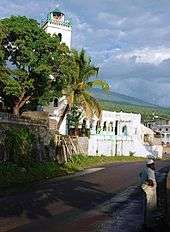
| Year | Million |
|---|---|
| 1950 | 0.16 |
| 2000 | 0.54 |
| 2018 | 0.8 |
With fewer than a million people, the Comoros is one of the least populous countries in the world, but is also one of the most densely populated, with an average of 275 inhabitants per square kilometre (710/sq mi). In 2001, 34% of the population was considered urban, but that is expected to grow, since rural population growth is negative, while overall population growth is still relatively high.[72]
Almost half the population of the Comoros is under the age of 15.[73] Major urban centres include Moroni, Mitsamihuli, Fumbuni, Mutsamudu, Domoni, and Fomboni. There are between 200,000 and 350,000 Comorians in France.[74]
Ethnic groups
The islands of the Comoros share mostly African-Arab origins. Minorities include Malagasy (Christian) and Indian (mostly Ismaili). There are recent immigrants of Chinese origin in Grande Comore (especially Moroni). Although most French left after independence in 1975, a small Creole community, descended from settlers from France, Madagascar and Réunion, lives in the Comoros.
Languages
The most common languages in the Comoros are the Comorian languages, collectively known Shikomori. They are related to Swahili, and the four different variants (Shingazidja, Shimwali, Shindzuani and Shimaore) are spoken on each of the four islands. Arabic and Latin scripts are both used, Arabic being the more widely used, and an official orthography has recently been developed for the Latin script.[75]
Arabic and French are also official languages, along with Comorian. Arabic is widely known as a second language, being the language of Quranic teaching. French is the administrative language and the language of most non-Quranic formal education.
Religion

Sunni Islam is the dominant religion, followed by as much as 99% of the population.[76] Comoros is the only Muslim-majority country in Southern Africa and the second southernmost Muslim-majority territory after the French territory of Mayotte.
A minority of the population of the Comoros are Christian, both Catholic and Protestant denominations are represented, and most Malagasy residents are also Christian. Expatriates from metropolitan France are mostly Catholic.[77]
Health
There are 15 physicians per 100,000 people. The fertility rate was 4.7 per adult woman in 2004. Life expectancy at birth is 67 for females and 62 for males.[78]
Education
Almost all children attend Quranic schools, usually before, although increasingly in tandem with regular schooling. Children are taught about the Qur'an, and memorise it, and learn the Arabic script. Most parents prefer their children to attend Koran schools before moving on to the French-based schooling system. Although the state sector is plagued by a lack of resources, and the teachers by unpaid salaries, there are numerous private and community schools of relatively good standard. The national curriculum, apart from a few years during the revolutionary period immediately post-independence, has been very much based on the French system, both because resources are French and most Comorians hope to go on to further education in France. There have recently been moves to Comorianise the syllabus and integrate the two systems, the formal and the Quran schools, into one, thus moving away from the secular educational system inherited from France.[79]
Pre-colonization education systems in Comoros focused on necessary skills such as agriculture, caring for livestock and completing household tasks. Religious education also taught children the virtues of Islam. The education system underwent a transformation during colonization in the early 1900s which brought secular education based on the French system. This was mainly for children of the elite. After Comoros gained independence in 1975, the education system changed again. Funding for teachers' salaries was lost, and many went on strike. Thus, the public education system was not functioning between 1997 and 2001. Since gaining independence, the education system has also undergone a democratization and options exist for those other than the elite. Enrollment has also grown.
In 2000, 44.2% of children ages 5 to 14 years were attending school. There is a general lack of facilities, equipment, qualified teachers, textbooks and other resources. Salaries for teachers are often so far in arrears that many refuse to work.[80]
Prior to 2000, students seeking a university education had to attend school outside of the country, however in the early 2000s a university was created in the country. This served to help economic growth and to fight the "flight" of many educated people who were not returning to the islands to work.[81]
About fifty-seven percent of the population is literate in the Latin script while more than 90% are literate in the Arabic script.[82] Comorian has no native script, but both Arabic and Latin scripts are used.
Culture
Traditionally, women on Ndzuani wear red and white patterned garments called shiromani, while on Ngazidja and Mwali colourful shawls called leso are worn. Many women apply a paste of ground sandalwood and coral called msinzano to their faces.[83] Traditional male clothing is a long white shirt known as a nkandu, and a bonnet called a kofia.[84]
Marriage
There are two types of marriages in Comoros, the little marriage (known as Mna daho on Ngazidja) and the customary marriage (known as ada on Ngazidja, harusi on the other islands). The little marriage is a simple legal marriage. It is small, intimate, and inexpensive and the bride's dowry is nominal. A man may undertake a number of Mna daho marriages in his lifetime, often at the same time, a woman fewer; but both men and women will usually only undertake one ada, or grand marriage, and this must generally be within the village. The hallmarks of the grand marriage are dazzling gold jewelry, two weeks of celebration and an enormous bridal dowry. Although the expenses are shared between both families as well as with a wider social circle, an ada wedding on Ngazidja can cost up to €50,000 (74,000 US dollars). Many couples take a lifetime to save for their ada, and it is not uncommon for a marriage to be attended by a couple's adult children.[85]
The ada marriage marks a man's transition in the Ngazidja age system from youth to elder. His status in the social hierarchy greatly increases, and he will henceforth be entitled to speak in public and participate in the political process, both in his village and more widely across the island. He will be entitled to display his status by wearing a mharuma, a type of shawl, across his shoulders, and he can enter the mosque by the door reserved for elders, and sit at the front. A woman's status also changes, although less formally, as she becomes a "mother" and moves into her own house. The system is less formalised on the other islands, but the marriage is nevertheless a significant and costly event across the archipelago.
The ada is often criticized because of its great expense, but at the same time it is a source of social cohesion and the main reason why migrants in France and elsewhere continue to send money home. Increasingly, marriages are also being taxed for the purposes of village development, so the effects are not entirely negative.[86]
Kinship and social structure

Comorian society has a bilateral descent system. Lineage membership and inheritance of immovable goods (land, housing) is matrilineal, passed in the maternal line, similar to many Bantu peoples who are also matrilineal, while other goods and patronymics are passed in the male line. However, there are differences between the islands, the matrilineal element being stronger on Ngazidja.[87]
Music
Twarab music, imported from Zanzibar in the early 20th century, remains the most influential genre on the islands and is popular at ada marriages.[88]
Media
There are two daily national newspapers published in the Comoros, the government-owned Al-Watwan,[89] and the privately owned La Gazette des Comores, both published in Moroni. There are a number of smaller newsletters published on an irregular basis as well as a variety of news websites. The government-owned ORTC provides national radio and television service and there are a number of privately owned stations broadcasting locally in the larger towns.
References
This article incorporates text from the Library of Congress Country Studies, which is in the public domain.
- "Comoros". International Monetary Fund. Retrieved 17 April 2012.
- "GINI index". World Bank. Archived from the original on 30 April 2014. Retrieved 26 July 2013.
- "Human Development Report 2019" (PDF). United Nations Development Programme. 10 December 2019. Retrieved 10 December 2019.
- ""World Population prospects – Population division"". population.un.org. United Nations Department of Economic and Social Affairs, Population Division. Retrieved 9 November 2019.
- ""Overall total population" – World Population Prospects: The 2019 Revision" (xslx). population.un.org (custom data acquired via website). United Nations Department of Economic and Social Affairs, Population Division. Retrieved 9 November 2019.
- The first UN General Assembly Resolution regarding the matter, "Question of the Comorian island of Mayotte (PDF)", United Nations General Assembly Resolution A/RES/31/4, (21 October 1976) states "the occupation by France of the Comorian island of Mayotte constitutes a flagrant encroachment on the national unity of the Comorian State, a Member of the United Nations," rejecting the French-administered referendums and condemning French presence in Mayotte.
- As defined by the Organization of African Unity, the Movement of Non-Aligned Countries, the Organisation of Islamic Cooperation, and the United Nations General Assembly: the most recent UN General Assembly Resolution regarding the matter, "Question of the Comorian island of Mayotte," United Nations General Assembly Resolution A/RES/49/18, (6 December 1994) states "the results of the referendum of 22 December 1974 were to be considered on a global basis and not island by island,...Reaffirms the sovereignty of the Islamic Federal Republic of the Comoros over the island of Mayotte". Several resolutions expressing similar sentiments were passed between 1977 (31/4) and 1994 (49/18).
- "Subjects of UN Security Council Vetoes". Global Policy Forum. Archived from the original on 17 March 2008. Retrieved 27 March 2008.
- "Article 33, Repertory, Supplement 5, vol. II (1970–1978)" (PDF). United Nations, Office of Legal Affairs (OLA). Archived from the original (PDF) on 6 October 2014.
- "Anti-French protests in Comoros". BBC News. 27 March 2008. Archived from the original on 28 March 2008. Retrieved 27 March 2008.
- "Intrigue in the world's most coup-prone island paradise". economist.com. The Economist. Archived from the original on 25 January 2019. Retrieved 25 January 2019.
- Human Development Indices Archived 19 December 2008 at the Wayback Machine, Table 3: Human and income poverty, p. 35. Retrieved on 1 June 2009
- "The Islands of the Moon". Aramco World. 47 (4): 40. July–August 1996. Archived from the original on 13 October 2007. Retrieved 20 September 2007.
- Alison Crowther; Leilani Lucas; Richard Helm; Mark Horton; Ceri Shipton; Henry T. Wright; et al. (2016). "Ancient crops provide first archaeological signature of the westward Austronesian expansion". Proceedings of the National Academy of Sciences. 113 (24): 6635–6640. doi:10.1073/pnas.1522714113.
- Nicolas Brucato; Veronica Fernandes; Stéphane Mazières; Pradiptajati Kusuma; Murray P. Cox; et al. (2018). "The Comoros show the earliest Austronesian gene flow into the Swahili Corridor". The American Journal of Human Genetics. 102: 58–68. doi:10.1016/j.ajhg.2017.11.011.
- Federal Research Division of the Library of Congress under the Country Studies/Area Handbook Program (August 1994). Ralph K. Benesch (ed.). A Country Study: Comoros. Washington, D.C.: US Department of the Army. Archived from the original on 12 January 2007. Retrieved 15 January 2007.
- Walker, Iain. "Islands in a Cosmopolitan Sea: A History of the Comoros." Hurst Publishers. 2019.
- Thomas Spear (2000). "Early Swahili History Reconsidered". The International Journal of African Historical Studies. 33 (2): 257–290. doi:10.2307/220649. JSTOR 220649.
- Pierre Vérin (1982). "Mtswa Muyindza et l'introduction de l'Islam à Ngazidja; au sujet de la tradition et du texte de Pechmarty". Etudes Océan Indien. 2: 95–100.
- Walker, Iain. "Islands in a Cosmopolitan Sea: A History of the Comoros." Hurst Publishers. 2019, p 49-50.
- Thomas Spear (1984). "The Shirazi in Swahili Traditions, Culture, and History". History in Africa. African Studies Association. 11: 291–305. doi:10.2307/3171638. JSTOR 3171638.
- Prestholdt, Jeremy (2007). "Similitude and empire: on Comorian strategies of Englishness". Journal of World History. 18 (2): 113–138.
- Walker, Iain. "Islands in a Cosmopolitan Sea: A History of the Comoros." Hurst Publishers. 2019, p 254.
- "Comoros – Early Visitors and Settlers Archived 13 June 2011 at the Wayback Machine". Library of Congress Country Studies
- "French acquisition of Comoros" (PDF). Encyclopedia of Islam 1979, vol. v, p. 381. Archived (PDF) from the original on 8 December 2015. Retrieved 18 November 2015.
- Ottenheimer, pp. 53–54
- Barbara Dubins (September 1969). "The Comoro Islands: A Bibliographical Essay". African Studies Bulletin. African Studies Association. 12 (2): 131–137. doi:10.2307/523155. JSTOR 523155.
- André Bourde (May 1965). "The Comoro Islands: Problems of a Microcosm". The Journal of Modern African Studies. 3 (1): 91–102. doi:10.1017/S0022278X00004924.
- Eliphas G. Mukonoweshuro (October 1990). "The Politics of Squalor and Dependency: Chronic Political Instability and Economic Collapse in the Comoro Islands". African Affairs. 89 (357): 555–577. doi:10.1093/oxfordjournals.afraf.a098331. JSTOR 722174.
- Moorcraft, Paul L.; McLaughlin, Peter (April 2008) [1982]. The Rhodesian War: A Military History. Barnsley: Pen and Sword Books. pp. 120–121. ISBN 978-1-84415-694-8.
- Abdourahim Said Bakar (1988). "Small Island Systems: A Case Study of the Comoro Islands". Comparative Education. 24 (2, Special Number (11): Education and Minority Groups): 181–191. doi:10.1080/0305006880240203.
- Christopher S. Wren (8 December 1989). "Mercenary Holding Island Nation Seeks Deal". New York Times. Archived from the original on 20 March 2017. Retrieved 6 February 2017.
- Judith Matloff (6 October 1995). "Mercenaries seek fun and profit in Africa". Christian Science Monitor. 87 (219). ISSN 0882-7729. Archived from the original on 24 October 2014. Retrieved 24 October 2014.
- Marlise Simons (5 October 1995). "1,000 French Troops Invade Comoros to Put Down Coup". New York Times. Section A; Page 10; Column 3. Archived from the original on 22 July 2016. Retrieved 6 February 2017.
- "French Mercenary Gives Up in Comoros Coup". New York Times. Associated Press. 6 October 1995. Section A; Page 7; Column 1. Archived from the original on 22 July 2016. Retrieved 6 February 2017.
- Kamal Eddine Saindou (6 November 1998). "Comoros president dies from heart attack". Associated Press. pp. International News. Archived from the original on 28 March 2015.
- Moyiga Nduru (17 September 1997). "COMORO ISLANDS: Tension Rising in the Indian Ocean Archipelago". IPS-Inter Press Service/Global Information Network. Archived from the original on 24 October 2014. Retrieved 24 October 2014.
- "COMOROS: COUP LEADER GIVES REASONS FOR COUP". BBC Monitoring Africa (Radio France Internationale). 1 May 1999.
- Rodrique Ngowi (3 August 2000). "Breakaway island's ruler says no civilian rule until secession crisis resolved". Associated Press.
- "Mbeki flies in to Comoros islands summit in bid to resolve political crisis". Agence France Presse. 20 December 2003.
- "Comoros said "calm" after Azali Assoumani declared elected as federal president". BBC Monitoring Africa. 10 May 2002.
- UN Integrated Regional Information Networks (15 May 2006). "Comoros; Ahmed Abdallah Sambi Set to Win Presidency by a Landslide". AllAfrica, Inc. Africa News.
- "COMOROS: The legacy of a Big Man on a small island". IRIN. Archived from the original on 20 December 2008. Retrieved 25 March 2009.
- Ottenheimer, pp. 20, 72
- Schipper, Jan. "Southern Africa: Island group between Madagascar". World Wildlife Fund. World Wildlife Fund. Retrieved 3 December 2019.
- "Prehistoric fish offers rare glimpse of hidden sea life – Coelacanth (1953)". Abilene Reporter-News. 23 February 1953. p. 25. Archived from the original on 1 April 2019. Retrieved 18 June 2017.
- "70-million-year-old fish dissected – Coaelacanth (1975)". Redlands Daily Facts. 28 May 1975. p. 6. Archived from the original on 1 April 2019. Retrieved 18 June 2017.
- "Comoros 2001 (rev. 2009)". Constitute. Archived from the original on 6 September 2015. Retrieved 23 April 2015.
- "FUNDAMENTAL LAW OF THE UNION OF COMOROS (English excerpts)". Centre for Human Rights, University of Pretoria, South Africa. Archived from the original (Word document) on 9 October 2006. Cite journal requires
|journal=(help) - AFRICAN ELECTIONS DATABASE Archived 9 July 2011 at the Wayback Machine, Elections in the Comoros.
- "COMOROS: Reforming 'the coup-coup islands'". IRIN. Archived from the original on 30 September 2009. Retrieved 25 March 2009.
- "Comoros: Referendum Approves Downscaling of Government". AllAfrica Global Media. 19 May 2009. Archived from the original on 25 May 2009. Retrieved 20 May 2009.
- Security Council S/PV. 1888 para 247 S/11967 Archived 17 March 2008 at the Wayback Machine
- "Forty-ninth session: Agenda item 36: 49/18. Question of the Comorian island of Mayotte" (PDF). United Nations General Assembly. 6 December 1994. Archived from the original (PDF) on 27 May 2008.
- "unfccc.int KYOTO PROTOCOL – STATUS OF RATIFICATION" (PDF). Unfccc.int. Archived from the original (PDF) on 18 September 2017. Retrieved 25 August 2017.
- "Chapter XXVI: Disarmament – No. 9 Treaty on the Prohibition of Nuclear Weapons". United Nations Treaty Collection. 7 July 2017.
- Office of the Prosecutor, Situation on Registered Vessels of Comoros, Greece and Cambodia Article 53(1) Report, "Report of 6th November 2014" Archived 19 March 2015 at the Wayback Machine
- Statement of the Prosecutor of the International Criminal Court, Fatou Bensouda, on concluding the preliminary examination of the situation referred by the Union of the Comoros: "Rome Statute legal requirements have not been met","Statement of 6th November 2014" Archived 2 June 2015 at the Wayback Machine
- Ratha, Dilip; Sanket Mohapatra; Ani Silwal (2011). "The Migration and Remittances Factbook 2011: Comoros" (PDF). Worldbank.org. Archived (PDF) from the original on 4 March 2016. Retrieved 29 November 2016.
- FINAL EVALUATION, Peace Building Fund Programme in the Comoros 2008–2011, 19 October 2011 – 8 November 2011
- Avery, Daniel (4 April 2019). "71 Countries Where Homosexuality is Illegal". Newsweek.
- "State-Sponsored Homophobia". International Lesbian Gay Bisexual Trans and Intersex Association. 20 March 2019.
- Latest Report on Poverty in the Comoros, World Bank (14 June 2018).
- Comoros: Big Troubles on Some Small Islands, Center for Strategic and International Studies (14 April 2008).
- Unemployment, total (% of total labor force) (modeled ILO estimate), International Labour Organization, ILOSTAT database. Data retrieved in December 2019.
- Office of the General Commissioner for Planning, Ministry of Planning and Regional Development (October 2005). "UNION OF THE COMOROS: POVERTY REDUCTION AND GROWTH STRATEGY PAPER (UPDATED INTERIM PAPER)" (PDF). Archived (PDF) from the original on 31 December 2006. Cite journal requires
|journal=(help) - Comoros: Economy, globalEDGE, Michigan State University (29 January 2020).
- Sarah Graingerm Comoros seeks sweet smell of success, BBC News (14 September 2004).
- "Comoros: Financial Sector Profile". mfw4a.org. Archived from the original on 13 May 2011. Retrieved 15 January 2011.
- "Rural Poverty Portal". ruralpovertyportal.org. Archived from the original on 18 January 2017. Retrieved 7 October 2016.
- "OHADA.com: The business law portal in Africa". Archived from the original on 26 March 2009. Retrieved 22 March 2009.
- Population Division of the Department of Economic and Social Affairs of the United Nations Secretariat (2005) World Population Prospects: The 2004 Revision and World Urbanization Prospects: The 2005 Revision Archived 23 June 2017 at the Wayback Machine.
- "Comoros Archived 26 June 2009 at the Wayback Machine". Encyclopædia Britannica.
- "FACTBOX-Relations between France and Comoros Archived 12 October 2017 at the Wayback Machine". Reuters. 27 March 2008.
- Mohamed Ahmed-Chamanga (2010). Introduction à la grammaire structurale du comorien. Moroni: Komedit.
- "The World Factbook — Central Intelligence Agency". cia.gov. Archived from the original on 6 April 2011. Retrieved 15 May 2007.
- "CIA World Factbook: Comoros". Cia.gov. Archived from the original on 6 April 2011. Retrieved 15 January 2011.
- "WHO Country Offices in the WHO African Region – WHO Regional Office for Africa" (PDF). Afro.who.int. Archived from the original (PDF) on 7 January 2010. Retrieved 1 June 2010.
- Damir Ben Ali & Iain Walker. 2017 “Attempts at fusion of the Comorian educational systems: religious education in Comorian and Arabic and secular education in French.” In I. Walker. ed., Contemporary issues in Swahili ethnography. London, New York: Routledge.
- "Comoros". 2005 Findings on the Worst Forms of Child Labor Archived 9 January 2014 at the Wayback Machine. Bureau of International Labor Affairs, U.S. Department of Labor (2006). This article incorporates text from this source, which is in the public domain.
- "Université des Comores". Univ-comores.km. Archived from the original on 3 May 2017. Retrieved 12 May 2017.
- UNESCO Institute for Statistics, country profile of Comoros; 2004 Archived 31 December 2006 at the Wayback Machine.
- "Union of Comoros". Arab Cultural Trust. Archived from the original on 27 December 2016. Retrieved 29 November 2016.
- "Comoros Islands: Islands & Beyond". comoros-islands.com. Archived from the original on 15 November 2016. Retrieved 29 November 2016.
- Walker, Iain (2002). "Les aspects économiques du grand mariage de Ngazidja". Autrepart. 23: 157–171.
- "Two Marriage Forms in the Comoro Islands: An Investigation". ProQuest 1298706914. Cite journal requires
|journal=(help) - Walker, Iain. "Becoming the Other, Being Oneself: Constructing Identities in a Connected World." Cambridge Scholars Publishing. 2010.
- Graebner, Werner (2001). "Twarab ya shingazidja: a first approach". Swahili Forum. 8: 129–143.
- "Accueil – Al-watwan, Quotidien comorien". Alwatwan.net. Archived from the original on 26 August 2017. Retrieved 25 August 2017.
Bibliography
- Martin Ottenheimer and Harriet Ottenheimer (1994). Historical Dictionary of the Comoro Islands. African Historical Dictionaries; No. 59. Metuchen, N.J.: Scarecrow Press. ISBN 978-0-585-07021-6.
- Iain Walker (2019). Islands in a Cosmopolitan Sea: A History of the Comoros. London: Hurst Publishers. ISBN 9781787381469.
External links
- Union des Comores – Official government website

- Comoros National Office of Tourism official website
- Embassy des Comores – The Federal and Islamic Republic of the Comoros in New York, United States
- Comoros web resources provided by GovPubs at the University of Colorado Boulder Libraries
- Comoros at Curlie
- Comoros from the BBC News
- Key Development Forecasts for Comoros from International Futures
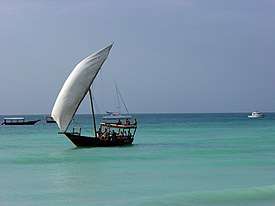
.svg.png)

